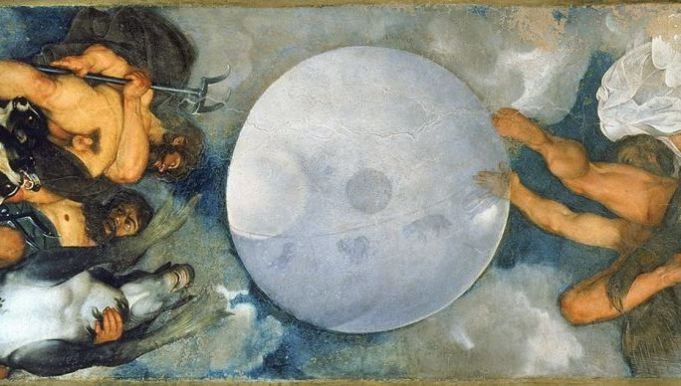Villa Aurora: Rome property with Caravaggio mural up for auction a second time
Historic villa goes under the hammer again after failing to sell at auction in January.
A Roman villa with the world's only Caravaggio ceiling painting goes up for sale a second time, on 7 April, after a court-ordered auction on 18 January failed to attract a single bid.
The reserve for the Casino di Villa Boncompagni Ludovisi, better known as Villa Aurora, has been slashed by about 20 per cent to €376 million, down from its original asking price of €471 million.
The auction starts at 14.00 on Thursday, with an opening bid of €282 million.
However, far from the glamour that one might expect from such a unique auction, the historic property will not go under the hammer in a prestigious sales room in Rome.
Instead it will be auctioned online, via a website that deals with bankruptcy property, among the forced sales of farmland, used furniture and second-hand cars.
The sale is the result of a bitter inheritance battle following the death in 2018 of Prince Nicolò Boncompagni Ludovisi, whose family has owned the historic property on Via Lombardia, near Via Veneto, for the last 400 years.
The dispute is between the prince's three sons from his first marriage and his third wife, the American-born Princess Rita Boncompagni Ludovisi, 72, who spent much of the last two decades renovating the 2,800-sqm property with her late husband.
The prince's sons contested their father's will, which the princess says entitles her to live in Villa Aurora for the rest of her life and, that if sold, the proceeds would be split between her and her stepsons.
After the two parties failed to reach an agreement, the courts ordered that the 11-bedroom villa be put up for auction, with the original estimated value of €471 million.
The courts stipulated that whoever purchases the property – protected under Italian cultural heritage laws – must spend a further €11 million on restoration costs.
Under Italian law, the government has a 60-day window to exercise its right of first refusal after a sale agreement to a private buyer, however even with the reduced price the state may not be able to afford the property, or wish to set a precedent.
Earlier this year more than 40,000 people signed an online petition urging the government to buy Villa Aurora by dipping into Italy's multi-billion National Plan of Recovery and Resilience (PNRR) funds, calling for the state to "safeguard what is ours" (despite the villa having always been privately owned).
Much of the property's astronomical price tag is attributed to the Caravaggio mural which was valued by Italian scholar Alessandro Zuccari at €310 million.The oil on plaster work, the only known ceiling painting by the Baroque master, dates to 1597.
The allegorical scene featuring Jupiter, Neptune and Pluto was commissioned by the villa's owner prior to the Ludovisi family – Cardinal Francesco Maria Del Monte – for his alchemy laboratory.
However the mural was subsequently covered up and was not rediscovered until 1968.
Jupiter, accompanied by an eagle, represents sulphur and air; Neptune, with a hippocamp, stands for mercury and water; and Pluto, with the three-headed dog Cerberus, represents salt and earth.
The mural, which measures 2.75 metres wide and is located in a camerino or small room on the first floor, depicts Jupiter reaching out to move the celestial sphere in which the sun revolves around the earth.

The villa is decorated too with lavish frescoes by the Italian Baroque painter Guercino, including one in the main reception hall of the Roman goddess of dawn, Aurora, which gives the building its name.
It is also home to works by Bril, Domenichino, Pomarancio and Viola; a staircase by architect Carlo Maderno who designed the façade of St Peter's; and its gardens include a statue of Pan attributed to Michelangelo.
Built in 1570, the villa has been owned since 1621 by the noble Ludovisi family whose descendants include Popes Gregory XIII – who introduced the Gregorian calendar – and Gregory XV.
The six-storey building, expanded in 1858, was used originally as the family's hunting lodge.
The property was once part of Villa Ludovisi, a 30-hectare country retreat established by Cardinal Del Monte.
In the late 19th century the Ludovisi family sold the bulk of the estate during Rome's construction boom, leading to the creation of the upmarket “Ludovisi” district.
The villa sits in what was once part of the Horti Sallustiani, a grand Roman estate with landscaped gardens, on land originally owned by Julius Caesar.
Recent surveys commissioned by Princess Rita and her late husband suggest that the ground on which the villa is built is exceptionally rich in archaeological treasures from the Roman era.
Over the centuries Villa Aurora has hosted many illustrious figures, from Galileo to Goethe, and was an important destination for visitors on the Grand Tour.
In his 1909 memoir Italian Hours, Henry James admired its rooms and sweeping rooftop views over Rome.
But while the villa's past is undeniably rich, what of its future?
Ahead of January's “auction of the century” the Italian media touted Microsoft founder Bill Gates or the Sultan of Brunei as possible future owners of the unique property.
With the arrival of the new auction date, the question is whether the lower price will tempt a billionaire from abroad or whether the Italian state will step in and turn the villa into a public museum.
Cover image: Villa Aurora. Photo Il Messaggero.
General Info
View on Map
Villa Aurora: Rome property with Caravaggio mural up for auction a second time
Via Ludovisi, 46, 00187 Roma RM, Italy

















